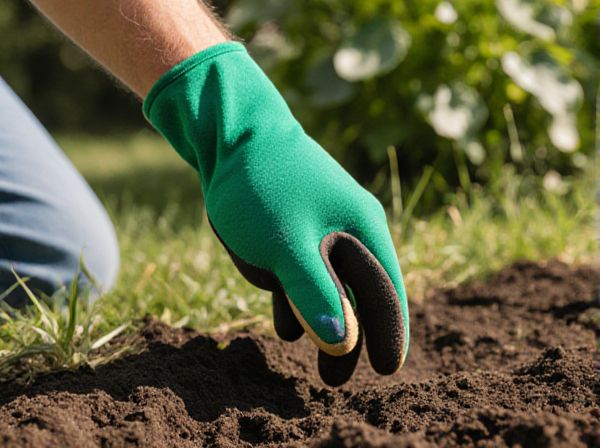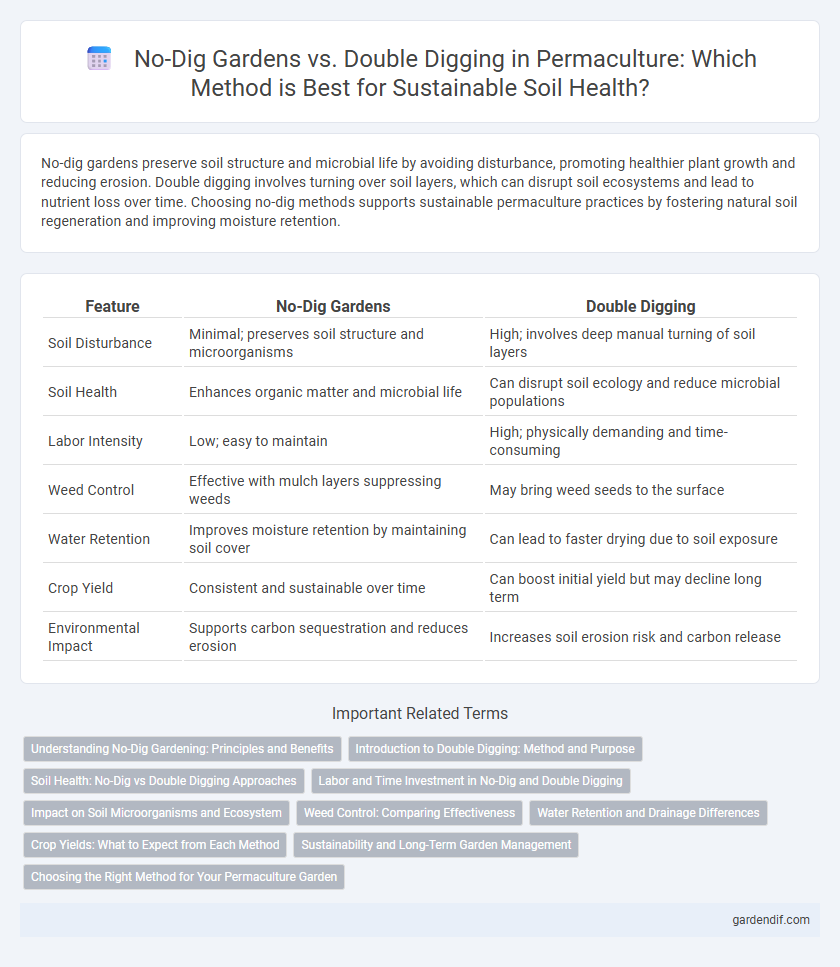
No-dig gardens vs double digging Illustration
No-dig gardens preserve soil structure and microbial life by avoiding disturbance, promoting healthier plant growth and reducing erosion. Double digging involves turning over soil layers, which can disrupt soil ecosystems and lead to nutrient loss over time. Choosing no-dig methods supports sustainable permaculture practices by fostering natural soil regeneration and improving moisture retention.
Table of Comparison
| Feature | No-Dig Gardens | Double Digging |
|---|---|---|
| Soil Disturbance | Minimal; preserves soil structure and microorganisms | High; involves deep manual turning of soil layers |
| Soil Health | Enhances organic matter and microbial life | Can disrupt soil ecology and reduce microbial populations |
| Labor Intensity | Low; easy to maintain | High; physically demanding and time-consuming |
| Weed Control | Effective with mulch layers suppressing weeds | May bring weed seeds to the surface |
| Water Retention | Improves moisture retention by maintaining soil cover | Can lead to faster drying due to soil exposure |
| Crop Yield | Consistent and sustainable over time | Can boost initial yield but may decline long term |
| Environmental Impact | Supports carbon sequestration and reduces erosion | Increases soil erosion risk and carbon release |
Understanding No-Dig Gardening: Principles and Benefits
No-dig gardening is a sustainable permaculture method that maintains soil structure by avoiding disturbance, promoting beneficial microbial activity and earthworm populations essential for nutrient cycling. Unlike double digging, which disrupts soil layers and can lead to erosion and loss of organic matter, no-dig systems build fertile topsoil through the layering of organic mulch and compost. This practice enhances moisture retention, reduces weed growth, and supports long-term soil health, making it a preferred technique for regenerative agriculture.
Introduction to Double Digging: Method and Purpose
Double digging is a traditional soil preparation method involving the removal and loosening of two soil layers to enhance aeration and root penetration, promoting healthier plant growth. This technique improves drainage and incorporates organic matter deeply, fostering nutrient-rich soil ideal for intensive gardening. Unlike no-dig gardens that maintain soil structure by minimal disturbance, double digging actively revitalizes compacted or poor soils to boost fertility and crop yields.
Soil Health: No-Dig vs Double Digging Approaches
No-dig gardens preserve soil structure and microbial life by minimizing disturbance, enhancing soil health through natural decomposition and earthworm activity. Double digging involves turning the soil deeply to aerate and loosen it but can disrupt soil ecosystems and reduce beneficial microorganism populations. Long-term soil fertility and carbon retention tend to be higher in no-dig systems due to less erosion and organic matter loss.
Labor and Time Investment in No-Dig and Double Digging
No-dig gardens require significantly less labor and time investment compared to double digging, as they eliminate intensive soil turning and disruption. Double digging demands deep, physical soil excavation, often taking several hours per bed, while no-dig methods rely on layering organic matter and minimal soil disturbance, speeding up garden establishment. This labor-efficient approach in no-dig gardening supports quicker setup and ongoing maintenance, making it ideal for gardeners with limited time or physical capacity.
Impact on Soil Microorganisms and Ecosystem
No-dig gardens preserve soil structure and promote diverse microbial communities by minimizing soil disturbance, which enhances nutrient cycling and ecosystem resilience. Double digging disrupts the soil profile, often reducing beneficial fungi and bacteria populations critical for plant health. Maintaining intact microbial networks in no-dig systems supports robust soil ecosystems and sustainable plant growth.
Weed Control: Comparing Effectiveness
No-dig gardens excel at weed control by preserving soil structure and maintaining a thick organic mulch layer that suppresses weed growth naturally. Double digging disrupts soil layers, which can inadvertently bring weed seeds to the surface, increasing weed emergence. Effective weed management in no-dig systems reduces labor and encourages beneficial soil organisms, leading to healthier plant growth.
Water Retention and Drainage Differences
No-dig gardens enhance water retention by preserving soil structure and organic matter, which increases moisture-holding capacity and reduces evaporation. Double digging, while improving soil aeration and drainage by loosening deeper layers, can disrupt soil ecosystems and lead to faster water runoff. The no-dig method supports natural water cycles, promoting healthier soil microbiomes and consistent moisture levels ideal for plant growth.
Crop Yields: What to Expect from Each Method
No-dig gardens typically promote higher crop yields by preserving soil structure, microbial life, and moisture retention, leading to healthier plant growth and less soil erosion. Double digging can increase aeration and root penetration initially, but frequent disturbance often disrupts soil ecosystems, potentially reducing long-term productivity. Research shows no-dig methods often produce more resilient crops with sustained yields over multiple growing seasons compared to traditional double digging.
Sustainability and Long-Term Garden Management
No-dig gardens enhance sustainability by preserving soil structure and microbial life, reducing erosion, and minimizing energy and labor inputs compared to double digging. This method fosters long-term garden health by maintaining consistent organic matter levels and encouraging beneficial soil organisms, leading to improved nutrient cycling and moisture retention. In contrast, double digging disrupts soil layers, which can cause compaction and degrade soil quality over time, requiring more frequent intervention and resource use.
Choosing the Right Method for Your Permaculture Garden
No-dig gardens promote soil health by preserving microbial life and organic matter, requiring less labor and reducing soil erosion compared to double digging. Double digging improves soil aeration and drainage by manually loosening deeper layers, which can be beneficial for compacted or clay-heavy soils in permaculture systems. Selecting the right method depends on soil condition, garden goals, and long-term sustainability, with no-dig favored for maintaining natural soil structure and double digging suited for initial soil rehabilitation.
No-dig gardens vs double digging Infographic

 gardendif.com
gardendif.com